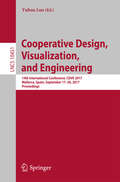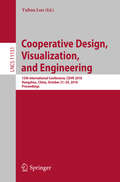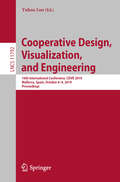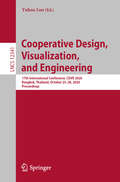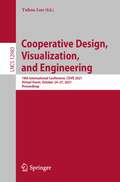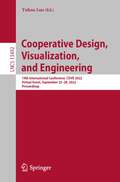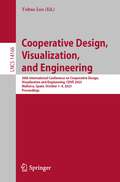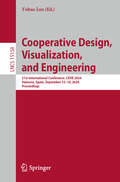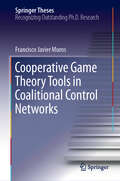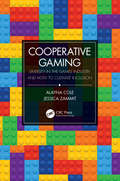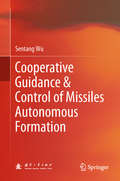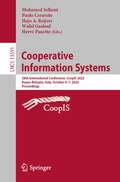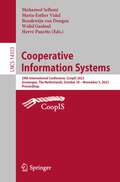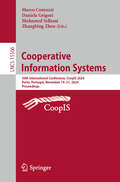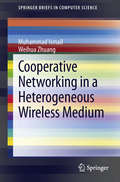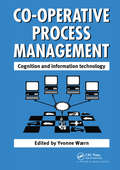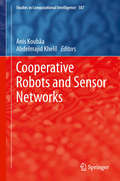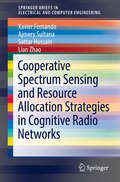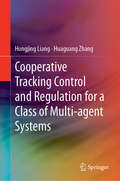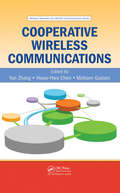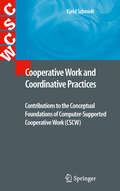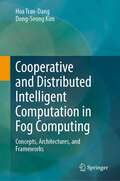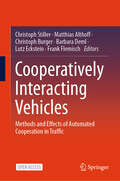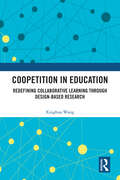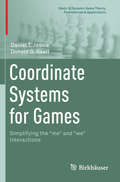- Table View
- List View
Cooperative Design, Visualization, and Engineering: 14th International Conference, CDVE 2017, Mallorca, Spain, September 17-20, 2017, Proceedings (Lecture Notes in Computer Science #10451)
by Yuhua LuoThis book constitutes the refereed proceedings of the 4th International Conference on Cooperative Design, Visualization, and Engineering, CDVE 2007, held in Shanghai, China in September 2007. The papers presented were carefully reviewed from numerous submissions. The papers cover all current issues in cooperative design, visualization, and engineering, ranging from theoretical and methodological topics to various systems and frameworks to applications in a variety of fields.
Cooperative Design, Visualization, and Engineering: 15th International Conference, CDVE 2018, Hangzhou, China, October 21–24, 2018, Proceedings (Lecture Notes in Computer Science #11151)
by Yuhua LuoThis book constitutes the refereed proceedings of the 15th International Conference on Cooperative Design, Visualization, and Engineering, CDVE 2018, held in Hangzhou, China, in October 2018. The 34 full papers presented in this book together with 15 short papers were carefully reviewed and selected from 75 submissions. The papers cover a broad range of topics in the field of cooperative visualization; cooperative design; cooperative engineering; basic theories, methods and technologies that support CDVE; and cooperative applications.
Cooperative Design, Visualization, and Engineering: 16th International Conference, CDVE 2019, Mallorca, Spain, October 6–9, 2019, Proceedings (Lecture Notes in Computer Science #11792)
by Yuhua LuoThis book constitutes the proceedings of the 16th International Conference on Cooperative Design, Visualization, and Engineering, CDVE 2019, held in Alcudia, Mallorca, Spain, in October 2019. The 26 revised full papers and 6 short papers presented were carefully reviewed and selected from 68 submissions. The achievement, progress and future challenges are reported in areas such as aerospace engineering, remote medical monitoring, automatic machine monitoring, cooperative personal data analytics, mobile banking, remote cooperative art performance management etc. In traditional areas such as architecture, civil engineering and construction, cooperative learning, enterprise management etc. authors also show new findings and new methodologies in their papers. This gives the readers a fresh look of how the CDVE technology is shaping our industry and daily life.
Cooperative Design, Visualization, and Engineering: 17th International Conference, CDVE 2020, Bangkok, Thailand, October 25–28, 2020, Proceedings (Lecture Notes in Computer Science #12341)
by Yuhua LuoThis book constitutes the proceedings of the 17th International Conference on Cooperative Design, Visualization, and Engineering, CDVE 2020, held in Bangkok, Thailand, in October 2020.*The 33 full papers and 7 short papers presented were carefully reviewed and selected from 74 submissions. The achievement, progress and future challenges are reported in areas such as health care, industrial design, banking IT systems, cultural activities support, operational maritime cybersecurity assurance, emotion communication, and social network data analytics. * The conference was held virtually due to the COVID-19 pandemic.
Cooperative Design, Visualization, and Engineering: 18th International Conference, CDVE 2021, Virtual Event, October 24–27, 2021, Proceedings (Lecture Notes in Computer Science #12983)
by Yuhua LuoThis book constitutes the proceedings of the 18th International Conference on Cooperative Design, Visualization, and Engineering, CDVE 2021, held in October 2021. Due to COVId-19 pandemic the conference was held virtually.The 25 full papers and 9 short papers presented were carefully reviewed and selected from 69 submissions. The achievement, progress and future challenges are reported in areas such as health care, industrial design, banking IT systems, cultural activities support, operational maritime cybersecurity assurance, emotion communication, and social network data analytics.
Cooperative Design, Visualization, and Engineering: 19th International Conference, CDVE 2022, Virtual Event, September 25–28, 2022, Proceedings (Lecture Notes in Computer Science #13492)
by Yuhua LuoThis book constitutes the proceedings of the 19th International Conference on Cooperative Design, Visualization, and Engineering, CDVE 2022, held in September 2022. Due to COVId-19 pandemic the conference was held virtually.The 27 full papers and 7 short papers presented were carefully reviewed and selected from 64 submissions. The papers cover a wide application spectrum including architecture, engineering and construction (AEC), apace craft building, heavy industry, robotics, tourism, education, community building, medical supply industry, commerce, etc.
Cooperative Design, Visualization, and Engineering: 20th International Conference on Cooperative Design, Visualization and Engineering, CDVE 2023, Mallorca, Spain, October 1–4, 2023, Proceedings (Lecture Notes in Computer Science #14166)
by Yuhua LuoThis book constitutes the proceedings of the 20th International Conference on Cooperative Design, Visualization, and Engineering, CDVE 2023, held in Palma de Mallorca, Spain, in October 2023. The 20 full papers and 6 short papers presented were carefully reviewed and selected from 62 submissions. The papers cover a wide application spectrum including architecture, engineering and construction (AEC), apace craft building, heavy industry, robotics, tourism, education, community building, medical supply industry, commerce.
Cooperative Design, Visualization, and Engineering: 21st International Conference, CDVE 2024, Valencia, Spain, September 15–18, 2024, Proceedings (Lecture Notes in Computer Science #15158)
by Yuhua LuoThis book constitutes the proceedings of the 21st International Conference on Cooperative Design, Visualization, and Engineering, CDVE 2024, held in Valencia, Spain, in September 2024. The 34 full papers and 5 short papers presented were carefully reviewed and selected from 74 submissions. The papers cover a wide application spectrum including AI technology, cooperative engineering, basic technologies for cooperative applications, IOT internet of things, block chain technology, sensor networks, and more.
Cooperative Game Theory Tools in Coalitional Control Networks (Springer Theses)
by Francisco Javier MurosThis book analyzes coalitional control schemes by incorporating concepts of cooperative game theory into a distributed control framework. It considers a networked architecture where the nodes are the agents and the edges are their communication links and either the agents or the links are established as the players of cooperative games related to the cost function of the coalitional schemes. The book discusses various cooperative game theory tools that are used to measure/analyze the players’ features, impose constraints on them, provide alternative methods of game computation, detect critical players inside the control scheme, and perform system partitioning of large-scale systems, such as the Barcelona drinking water network, which is described in a case study.
Cooperative Gaming: Diversity in the Games Industry and How to Cultivate Inclusion (ERROR)
by Alayna Cole Jessica ZammitDescription Cooperative Gaming provides context and practical advice regarding diversity in the games industry. The book begins with a deep dive into research literature and the history of diversity in the games industry to provide context around what diversity is and why it is a topic worth considering. The book looks at the different facets of diversity and games, exploring the issues and solutions within game development, studio management, event planning, and more. It provides people with practical advice about being a marginalized person in the games industry and how to be heard, how studios can support inclusive practices, and events can actively become more accessible to a diverse audience. Key Features • Explores the history of diversity in games • Provides important information around what it is like to be a marginalized person in the industry • Gives practical steps to improve the inclusivity of the industry that are designed to aid in contextualizing and upskilling new developers Author Bios Alayna Cole is the managing director of Queerly Represent Me, a not-for-profit championing queer representation in games. Alayna is also a producer at Sledgehammer Games, co-chair of the IGDA LGBTQ+ special interest group, and an award-winning games journalist and game developer. She was featured on the 2016 and 2017 Develop Pacific 30 Under 30 lists and the 2017 and 2019 Develop Pacific Women in Games lists, and she has received several other accolades in the industry. Jessica Zammit started writing in 2013 for Start Select Media, and for the next five years she followed her interest in writing about representations of mental health, diversity, and particularly, sexuality in video games. Jessica has been speaking about diversity in games at conventions such as PAX Australia since 2016 and has been featured on several other discussions in and around the topic of representation in games and games criticism. Along with her co-author, she is co-chair of the IGDA LGBTQ+ special interest group, and she was featured on the 2018 Develop Pacific 30 Under 30 and Women in Games lists.
Cooperative Guidance & Control of Missiles Autonomous Formation
by Sentang WuThis book primarily illustrates the rationale, design and technical realization/verification for the cooperative guidance and control systems (CGCSs) of missile autonomous formation (MAF). From the seven functions to the five major compositions of CGCS, the book systematically explains the theory and modeling, analysis, synthesis and design of CGCSs for MAF, including bionics-based theories.Further, the book addresses how to create corresponding digital simulation analysis systems, as well as hardware in the loop (HIL) simulation test systems and flight test systems, to evaluate the combat effectiveness of MAF. Lastly, it provides detailed information on digital simulation analysis for a large range of wind tunnel test data, as well as test results of HIL system simulations and embedded systems testing.
Cooperative Information Systems: 28th International Conference, CoopIS 2022, Bozen-Bolzano, Italy, October 4–7, 2022, Proceedings (Lecture Notes in Computer Science #13591)
by Paolo Ceravolo Walid Gaaloul Hajo A. Reijers Hervé Panetto Mohamed SellamiThis volume LNCS 13591 constitutes the proceedings of the International Conference on Cooperative Information Systems, CoopIS 2022, collocated with the Enterprise Design, Operations and Computing conference, EDOC 2022, in October 2022 in Bozen-Bolzano, Italy. The 15 regular papers presented together with 5 research in progress papers were carefully reviewed and selected from 68 submissions. The conference focuses on technical, economical, and societal aspects of distributed information systems at scale. As said, this 28th edition was collocated with the 26th edition of the Enterprise Design, Operations and Computing conference, EDOC 2022, and its guiding theme was "Information Systems in a Digital World“.
Cooperative Information Systems: 29th International Conference, CoopIS 2023, Groningen, The Netherlands, October 30–November 3, 2023, Proceedings (Lecture Notes in Computer Science #14353)
by Maria-Esther Vidal Walid Gaaloul Hervé Panetto Boudewijn Van Dongen Mohamed SellamiThis book constitutes the refereed proceedings of the 29th International Conference on Cooperative Information Systems, CoopIS 2023, held in Groningen, The Netherlands, during October 30–November 3, 2023. The 21 regular papers and 10 work-in-progress papers included in this book were carefully reviewed and selected from 100 submissions. They were organized in topical sections as follows: Knowledge Engineering; Deployment and Migration in CISs; Security and Privacy in CISs; Process Modeling; Process Analytics; Human Aspects and Social Interaction in CISs; and Work in Progress.
Cooperative Information Systems: 30th International Conference, CoopIS 2024, Porto, Portugal, November 19–21, 2024, Proceedings (Lecture Notes in Computer Science #15506)
by Daniela Grigori Zhangbing Zhou Mohamed Sellami Marco ComuzziThis book constitutes the refereed proceedings of the 30th International Conference on Cooperative Information Systems, CoopIS 2024, held in Porto, Portugal, during November 19-21, 2024. The 16 full papers, 11 short papers and 2 invited papers were carefully reviewed and selected from 78 submissions. They were organized in topical sections as follows: processes and human-in-the-loop; process analytics and technology; process improvement; knowledge graphs and knowledge engineering; predictive process monitoring; services and cloud; and short papers.
Cooperative Networking in a Heterogeneous Wireless Medium (SpringerBriefs in Computer Science)
by Weihua Zhuang Muhammad IsmailThis brief focuses on radio resource allocation in a heterogeneous wireless medium. It presents radio resource allocation algorithms with decentralized implementation, which support both single-network and multi-homing services. The brief provides a set of cooperative networking algorithms, which rely on the concepts of short-term call traffic load prediction, network cooperation, convex optimization, and decomposition theory. In the proposed solutions, mobile terminals play an active role in the resource allocation operation, instead of their traditional role as passive service recipients in the networking environment.
Cooperative Process Management: Cognition And Information Technology
by Yvonne WærnCovering analysis, field studies, micro-world studies, training and the creation of computer artefacts under the Co-operative Process Management umbrella.
Cooperative Robots and Sensor Networks (Studies in Computational Intelligence #507)
by Anis Koubâa Abdelmajid KhelilMobile robots and Wireless Sensor Networks (WSNs) have enabled great potentials and a large space for ubiquitous and pervasive applications. Robotics and WSNs have mostly been considered as separate research fields and little work has investigated the marriage between these two technologies. However, these two technologies share several features, enable common cyber-physical applications and provide complementary support to each other. The primary objective of book is to provide a reference for cutting-edge studies and research trends pertaining to robotics and sensor networks, and in particular for the coupling between them. The book consists of five chapters. The first chapter presents a cooperation strategy for teams of multiple autonomous vehicles to solve the rendezvous problem. The second chapter is motivated by the need to improve existing solutions that deal with connectivity prediction, and proposed a genetic machine learning approach for link-quality prediction. The third chapter presents an architecture for indoor navigation using an Android smartphone for guiding a variety of users, from sighted to the visually impaired, to their intended destination. In chapter four, the authors deal with accurate prediction modeling of ocean currents for underwater glider navigation. In chapter five, the authors discuss the challenges and limitations of RSS-based localization mechanisms and propose, EasyLoc, an autonomous and practical RSS-based localization technique that satisfies ease of deployment and implementation.
Cooperative Spectrum Sensing and Resource Allocation Strategies in Cognitive Radio Networks (SpringerBriefs in Electrical and Computer Engineering)
by Lian Zhao Xavier Fernando Ajmery Sultana Sattar HussainCognitive radio networks (CRN) will be widely deployed in the near future, and this SpringerBrief covers some important aspects of it, as well as highlighting optimization strategies in Resource Allocation and Spectrum Sensing in CRNs. The cognitive approach in radio access is introduced in the first part of this SpringerBrief, and then next the benefits of cooperative spectrum sensing are highlighted and a framework for studying it under realistic channel conditions is described. New exact closed-form expressions for average false alarm probability and average detection probability are derived in this scenario. A novel approximation to alleviate the computational complexity of the proposed models are also discussed.Once the spectrum opportunities are identified, efficient and systematic resource allocation (RA) shall be performed. The second part of this SpringerBrief describes the taxonomy for the RA process in CRN. A comprehensive overview of the optimization strategies of the CRN RA is also provided. The device-to-device (D2D) communication scenario is discussed, then as a case study and various optimization strategies for the application of the CR technology in the D2D realm is studied. The application of advanced geometric water-filling (GWF) approach in CRN D2D environment for optimum resource allocation is presented in detail. Numerical results provide more insight quantitatively. Overall, this book is suitable for a wide audience that include students, faculty and researchers in wireless communication area and professionals in the wireless service industry.
Cooperative Tracking Control and Regulation for a Class of Multi-agent Systems
by Huaguang Zhang Hongjing LiangThis book focuses on the characteristics of cooperative control problems for general linear multi-agent systems, including formation control, air traffic control, rendezvous, foraging, role assignment, and cooperative search. On this basis and combined with linear system theory, it introduces readers to the cooperative tracking problem for identical continuous-time multi-agent systems under state-coupled dynamics; the cooperative output regulation for heterogeneous multi-agent systems; and the optimal output regulation for model-free multi-agent systems. In closing, the results are extended to multiple leaders, and cooperative containment control for uncertain multi-agent systems is addressed. Given its scope, the book offers an essential reference guide for researchers and designers of multi-agent systems, as well as a valuable resource for upper-level undergraduate and graduate students.
Cooperative Wireless Communications
by Yan Zhang Hsiao-Hwa Chen Mohsen GuizaniCooperative devices and mechanisms are increasingly important to enhance the performance of wireless communications and networks, with their ability to decrease power consumption and packet loss rate and increase system capacity, computation, and network resilience. Considering the wide range of applications, strategies, and benefits associated wit
Cooperative Work and Coordinative Practices: Contributions to the Conceptual Foundations of Computer-Supported Cooperative Work (CSCW) (Computer Supported Cooperative Work)
by Kjeld SchmidtInformation technology has been used in organisational settings and for organisational purposes such as accounting, for a half century, but IT is now increasingly being used for the purposes of mediating and regulating complex activities in which multiple professional users are involved, such as in factories, hospitals, architectural offices, and so on. The economic importance of such coordination systems is enormous but their design often inadequate. The problem is that our understanding of the coordinative practices for which these systems are developed is deficient, leaving systems developers and software engineers to base their designs on commonsensical requirements analyses. The research reflected in this book addresses these very problems. It is a collection of articles which establish a conceptual foundation for the research area of Computer-Supported Cooperative Work.
Cooperative and Distributed Intelligent Computation in Fog Computing: Concepts, Architectures, and Frameworks
by Dong-Seong Kim Hoa Tran-DangThis informative text/reference presents a detailed review of the state of the art in fog computing paradigm. In particular, the book examines a broad range of important cooperative and distributed computation algorithms, along with their design objectives and technical challenges. The coverage includes the conceptual fundamental of fog computing, its practical applications, cooperative and distributed computation algorithms using optimization, swarm intelligence, matching theory, and reinforcement learning methods. Discussions are also provided on remaining challenges and open research issues for designing and developing the efficient distributed computation solutions in the next-generation of fog-enabled IoT systems.
Cooperatively Interacting Vehicles: Methods and Effects of Automated Cooperation in Traffic
by Barbara Deml Christoph Burger Frank Flemisch Lutz Eckstein Christoph Stiller Matthias AlthoffThis open access book explores the recent developments automated driving and Car2x-communications are opening up attractive opportunities future mobility. The DFG priority program “Cooperatively Interacting Automobiles” has focused on the scientific foundations for communication-based automated cooperativity in traffic. Communication among traffic participants allows for safe and convenient traffic that will emerge in swarm like flow. This book investigates requirements for a cooperative transport system, motion generation that is safe and effective and yields social acceptance by all road users, as well as appropriate system architectures and robust cooperative cognition. For many years, traffic will not be fully automated, but automated vehicles share their space with manually driven vehicles, two-wheelers, pedestrians, and others. Such a mixed traffic scenario exhibits numerous facets of potential cooperation. Automated vehicles must understand basic principles of human interaction in traffic situations. Methods for the anticipation of human movement as well as methods for generating behavior that can be anticipated by others are required. Explicit maneuver coordination among automated vehicles using Car2X-communications allows generation of safe trajectories within milliseconds, even in safety-critical situations, in which drivers are unable to communicate and react, whereas today's vehicles delete their information after passing through a situation, cooperatively interacting automobiles should aggregate their knowledge in a collective data and information base and make it available to subsequent traffic.
Coopetition in Education: Redefining Collaborative Learning through Design-Based Research
by Xinghua WangThe book explores the development of coopetition designs aimed at enhancing student collaborative learning, addressing persistent challenges such as low individual accountability and the associated free-rider issue.Moving beyond the long-standing and inconclusive debates between collaboration and competition, the book embraces the concept of coopetition—a hybrid approach that merges the strengths of both collaboration and competition while mitigating their respective weaknesses. The author develops two initial coopetition designs: social-comparison coopetition and zero-sum coopetition, both of which underwent rigorous examination and refinement through three iterative research cycles, followed by the design-based research methodology. He reveals that social-comparison coopetition consistently outperformed other designs across all cycles, demonstrating enhanced student motivation, engagement, and self-regulated learning. By contrast, while zero-sum coopetition showed slight advantages in one-off applications, its repeated use required careful handling. In conclusion, the book introduces two key design principles that define the core components and appropriate contexts for implementing coopetition, with a particular emphasis on social-comparison coopetition.The book will be valuable for researchers, educators, and teachers looking for new theories and strategies to enhance collaborative learning.
Coordinate Systems for Games: Simplifying the "me" and "we" Interactions (Static & Dynamic Game Theory: Foundations & Applications)
by Donald G. Saari Daniel T. JessieThis monograph develops a method of creating convenient coordinate systems for game theory that will allow readers to more easily understand, analyze, and create games at various levels of complexity. By identifying the unique characterization of games that separates the individual’s strategic interests from the group’s collective behavior, the authors construct a single analytical methodology that readers will be able to apply to a wide variety of games. With its emphasis on practicality and approachability, readers will find this book an invaluable tool, and a viable alternative to the ad hoc analytical approach that has become customary for researchers utilizing game theory.The introductory chapters serve two important purposes: they review several games of fundamental importance, and also introduce a dynamic that is inherent in games, but has gone unexplored until now. After this has been established, readers will advance from simple 2 x 2 games to games with more player strategies and dynamics. For interested readers, a rigorous treatment of the underlying mathematics is conveniently gathered at the end of the book. Additional topics of interest, such as extensive form and coalitional games, are presented to help readers visualize more complex settings that will be vital in aiding the understanding of advanced topics, such as coalition-free Nash points, multi-player repeated games, and more.Coordinate Systems for Games is ideal for a wide variety of researchers interested in game theory, including social scientists, economists, mathematicians, computer scientists, and more. The authors' approachable style also makes this accessible to an audience at any scale of experience, from beginning non-specialists to more practiced researchers.
